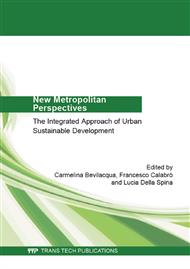[1]
Committee for Economic Development (CED) (1982): Public-private partnership. An Opportunity for Urban Communities. Washington, D. C.
Google Scholar
[2]
CUED (1978): Coordinated Urban Economic Development.
Google Scholar
[3]
P. Newman, G. Verpraet: The impacts of partnership on urban governance: conclusions from recent European research. Regional Studies, Vol. 33, No. 5, (1999), p.487.
DOI: 10.1080/00343409950081338
Google Scholar
[4]
Committee for Economic Development (CED) (1978: 296).
Google Scholar
[5]
D. Haider: in: P. Davis, Public-Private Partnerships: Improving Urban Life, (1986).
Google Scholar
[6]
F. Calabrò, L. Della Spina: The public-private partnerships in buildings regeneration: a model appraisal of the benefits and for land value capture. In: 5nd KKU International Engineering Conference 2014 (KKU-IENC 2014). ADVANCED MATERIALS RESEARCH, Vols. 931-932 (2014).
DOI: 10.4028/www.scientific.net/amr.931-932.555
Google Scholar
[7]
S. A. Grossman: The Case of Business Improvement Districts. Special District Public–Private Cooperation in Community Revitalization, in Public Performance & Management Review, 32 (2), (2008), pp.290-308.
DOI: 10.2753/pmr1530-9576320206
Google Scholar
[8]
J. Mitchell, Business Improvement Districts and Innovative Service Delivery, The PricewaterhouseCoopers Endowment for the Business of Government, New York (1999).
Google Scholar
[9]
J. Mac Donald, R. Stokes, R. Bluthenthal: The Role of Community Context in Business District Revitalization Strategies. Business Improvement Districts in Los Angeles, in Public Performance & Management Review, 33(3), (2010), pp.436-458.
DOI: 10.2753/pmr1530-9576330307
Google Scholar
[10]
J. Mitchell: Business Improvement Districts and the 'New', Revitalization of Downtown, in Economic Development Quarterly, 15, (2001), pp.115-123.
DOI: 10.1177/089124240101500201
Google Scholar
[11]
S. A. Grossman: The Case of Business Improvement Districts. Special District Public–Private Cooperation in Community Revitalization, in Public Performance & Management Review, 32 (2), (2008), pp.290-308.
DOI: 10.2753/pmr1530-9576320206
Google Scholar
[12]
R. Stoecker: The CDC Model Of Urban Redevelopment: A Critique and an Alternative. Journal of urban affairs, Volume 19, Number 1, (1997), pp.1-22.
DOI: 10.1111/j.1467-9906.1997.tb00392.x
Google Scholar
[13]
Information on: http: /www. preservationnation. org/main-street/about-main-street/the-approach.
Google Scholar
[14]
K. A. Robertson: The main street approach to downtown development: an examination of the four-point program, Journal of Architectural and Planning Research, Locke Science Publishing Company, Inc. Chicago, IL, USA.
Google Scholar
[15]
A. L. Dono, L. S. Glisson: Revitalizing main street: a practitioner's guide to comprehensive commercial district revitalization, Washington, DC: Main Street, National Trust for Historic Preservation/National Trust Main Street Center (2009).
Google Scholar
[16]
S. G. Dane: Main Street success stories, National Main Street Center, National Trust for Historic Preservation (1997).
Google Scholar
[17]
F. Calabrò, L. Della Spina: The cultural and environmental resources for sustainable development of rural areas in economically disadvantaged contexts. Economic-appraisals issues of a model of management for the valorisation of public assets. In 3rd International Conference on Energy, Environment and Sustainable Development (ICEESD 2013). Advanced Materials Research Vols. 869-870 (2014).
DOI: 10.4028/www.scientific.net/amr.869-870.43
Google Scholar
[18]
G. M. Trimble, S. L. Rogel: Codevelopment Rebuilds Downtown Excitement, In: ULI (1983).
Google Scholar
[19]
V. Vasquez: The economic impact of business improvement districts (bids) in San Diego, National University System Institute for policy research (2012).
Google Scholar


